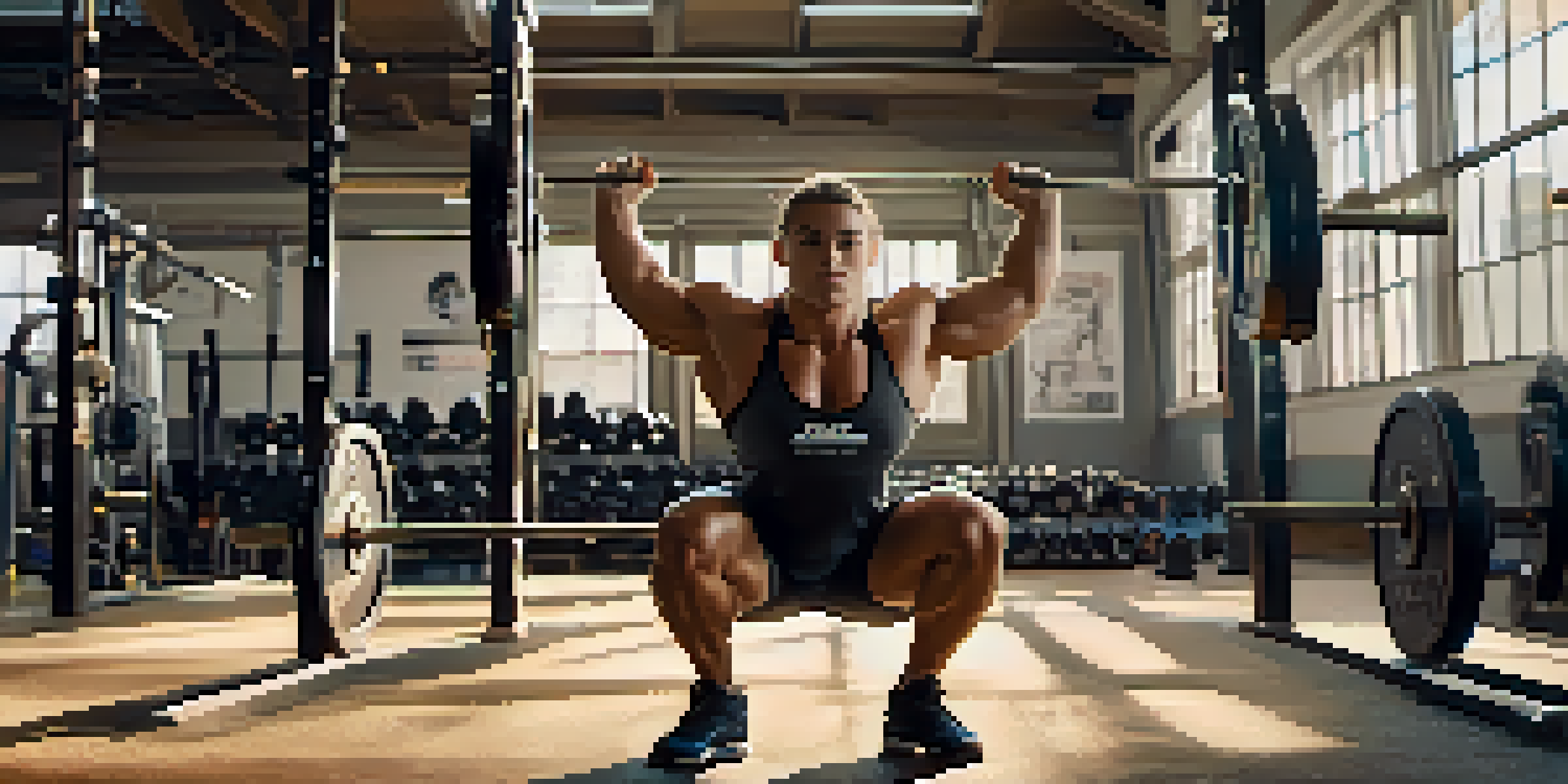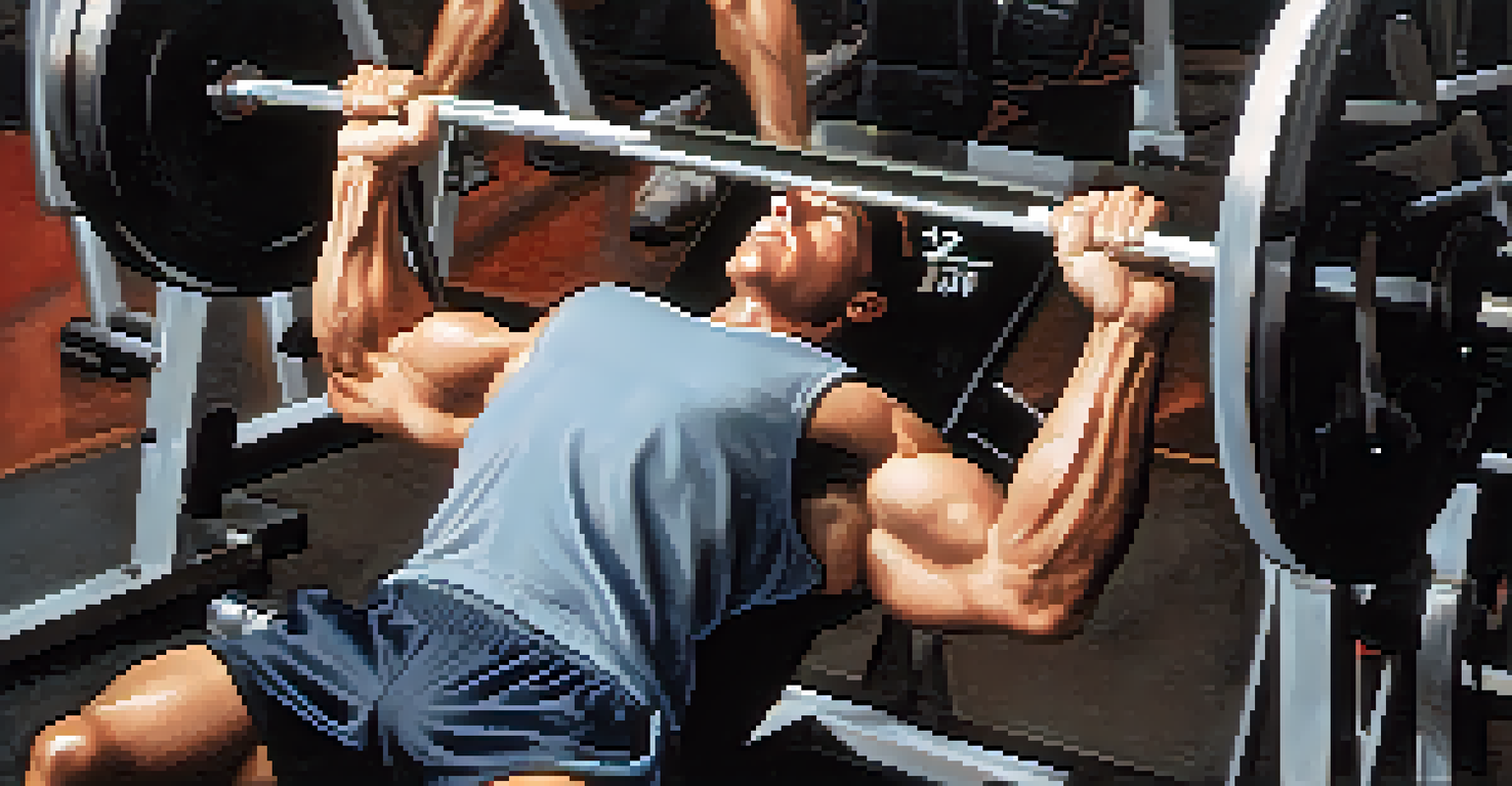Understanding the Biomechanics of Powerlifting Movements

What Is Biomechanics and Why It Matters in Powerlifting
Biomechanics is the study of how our bodies move, especially under load. In powerlifting, understanding biomechanics is essential because it helps lifters optimize their movements to lift heavier weights safely. By analyzing body mechanics, athletes can improve their technique, reduce the risk of injury, and enhance overall performance.
The human body is a machine that can be optimized for performance through understanding its mechanics.
For instance, consider the squat. Proper biomechanics involve the alignment of the knees, hips, and spine, ensuring that the load is evenly distributed. This not only maximizes strength but also safeguards the joints from undue stress. By grasping these principles, lifters can make informed decisions about their training routines.
Ultimately, biomechanics serves as the foundation for effective training. Lifters who pay attention to their body's mechanics can unlock their potential, achieving personal records while minimizing injuries. It's about moving smarter, not just harder.
The Squat: Analyzing the Mechanics of the Movement
The squat is a fundamental powerlifting movement that engages multiple muscle groups, including the quadriceps, hamstrings, and glutes. Proper squat mechanics are crucial for maximizing strength and preventing injury. Factors such as foot placement, knee tracking, and hip hinge all play significant roles in the effectiveness of the squat.

When performed correctly, the squat allows for optimal force generation and muscle recruitment. For example, maintaining a neutral spine and ensuring the knees track over the toes can help distribute the load more effectively, leading to better performance. Conversely, poor form can result in misalignment and potential injuries, making it vital to master the squat's mechanics.
Biomechanics Enhances Lifting Safety
Understanding biomechanics helps powerlifters optimize their movements, improving technique and reducing injury risk.
Practicing with lighter weights to focus on form can help lifters internalize the proper mechanics. Once comfortable, they can gradually increase the load, confident in their technique. As a staple in powerlifting, mastering the squat can significantly impact an athlete's overall performance.
The Deadlift: Key Biomechanical Principles Explained
The deadlift is another cornerstone of powerlifting that tests overall strength and conditioning. Biomechanically, it involves lifting a loaded barbell from the ground to hip level, engaging muscles throughout the back, legs, and core. Understanding the mechanics behind this lift can drastically improve a lifter's efficiency and strength.
In powerlifting, technique and biomechanics are just as important as strength training itself.
Key aspects of the deadlift include maintaining a flat back, proper grip width, and foot positioning. For example, a lifter's hips should be positioned correctly to prevent excessive rounding of the back, which could lead to injury. The more aligned the body is during the lift, the more power the lifter can generate.
Regularly practicing deadlifts with an emphasis on form can help athletes develop a stronger foundation. As lifters become more comfortable with the mechanics, they can focus on gradually increasing their weights. This combination of proper technique and progressive overload is essential for success in powerlifting.
The Bench Press: Understanding Upper Body Biomechanics
The bench press is a critical powerlifting movement that targets the chest, shoulders, and triceps. Biomechanically, it requires precise positioning and movement patterns to ensure maximum strength output. Understanding the mechanics of the bench press can help lifters optimize their performance and avoid common pitfalls.
Key factors include grip width, elbow positioning, and shoulder stability. For instance, a wider grip can engage more of the chest muscles, while keeping the elbows tucked can reduce shoulder strain. Focusing on these details can lead to more efficient lifting and greater gains in strength.
Core Stability is Essential for Lifts
A strong core is crucial for maintaining proper posture and balance during powerlifting movements, enabling efficient force transfer.
Additionally, lifters should pay attention to their foot placement and the arch of their back during the lift. A stable base allows for better power transfer from the legs through the core and into the upper body. By mastering these biomechanical principles, athletes can enhance their bench press performance and overall lifting success.
The Role of Core Stability in Powerlifting Movements
Core stability is crucial in powerlifting, as it helps maintain proper posture and balance during lifts. A strong core acts as a foundation, allowing lifters to transfer force efficiently throughout their bodies. Poor core stability can lead to compromised lifting mechanics and increased risk of injury.
During lifts like the squat and deadlift, a stable core helps keep the spine aligned and supports overall body mechanics. For example, engaging the core muscles creates intra-abdominal pressure, which stabilizes the spine and allows for heavier lifts. This highlights the importance of core training in a powerlifting regimen.
Incorporating exercises that strengthen the core, such as planks or rotational movements, can enhance overall performance. Lifters who prioritize core stability will likely find improvements in their lifting technique and the ability to handle heavier weights. It's a vital component of a successful powerlifting strategy.
Injury Prevention Strategies Through Biomechanics
Injury prevention is a top concern for powerlifters, and understanding biomechanics plays a vital role in safeguarding against injuries. Many injuries arise from improper technique or overloading the body without adequate preparation. By studying biomechanics, lifters can identify potential risks and take proactive measures.
For example, ensuring proper alignment during lifts can help distribute forces evenly across joints and muscles. Additionally, incorporating mobility and flexibility training can address imbalances that may lead to injuries. Athletes who prioritize these aspects of their training can create a solid foundation for long-term lifting success.
Tailored Training Plans Boost Performance
Incorporating biomechanical principles into training plans allows lifters to customize their workouts for improved performance and progress.
Furthermore, regular assessments of lifting technique can help identify areas for improvement. Lifters can benefit from working with coaches or using video analysis to evaluate their form. By staying mindful of biomechanics, powerlifters can not only enhance their performance but also significantly reduce their risk of injury.
Integrating Biomechanics into Powerlifting Training Plans
Incorporating biomechanics into powerlifting training plans can lead to more effective and tailored workouts. By understanding how the body moves during each lift, athletes can create specific goals and strategies that cater to their unique mechanics. This personalized approach can enhance overall performance and progress.
For instance, a lifter who struggles with maintaining a neutral spine during squats may benefit from drills focused on core stability and flexibility. Similarly, someone with issues in their bench press technique might focus on shoulder mobility exercises. Customizing training based on biomechanical principles can lead to significant improvements.

Additionally, monitoring progress and making adjustments based on biomechanical feedback is crucial. Lifters should regularly assess their technique and adapt their training plans as needed. By continuously integrating biomechanics into their training, powerlifters can unlock their full potential and achieve their goals.